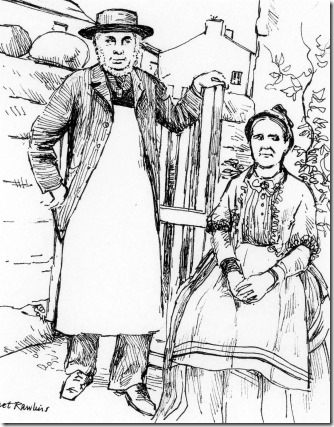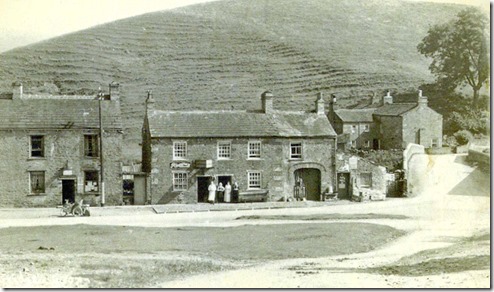I edited Peter Leyland’s story about his family in Bainbridge from his talk to the Friends of the Dales Countryside Museum and the oral history recordings I made in 2008. This was first published in the Now Then magazine in 2009. This annual magazine is published by the Friends of the Dales Countryside Museum. Peter died in 2010. His widow is the artist Janet Rawlins.
My great great grandfather was called Alexander Tiplady, or Alec Tiplady, and he was born in Askrigg. He fought in the battle of Waterloo and, when he came back, he married an Askrigg girl called Mary Metcalfe and decided to open a shop in Bainbridge.
He started the general store with groceries and draperies and so on in 1816 and this was carried on by his son John Tiplady. John married Mary Ann Routh from Hawes and they had one daughter, Mary. (Below: John and Mary Ann Tiplady. Drawn by Janet Rawlins from a photo.)
They didn’t go to cash and carry in those days but had commercial travellers who came round touting their wares. A lot of them used to come on the train to Askrigg and they would walk on to Bainbridge carrying their bags and take orders from the shop. One of these commercial travellers, although I don’t think he ever called himself that, was John Leyland from a firm in Bradford. He married Mary and they carried on with the shop after my great grandfather died.
My father was born in 1890. My grandfather died in 1918 just before my mother (Isobel Chapman) and father were married. They were married in 1919 and I was born in 1920. My given name was John because the eldest son of the family for three to four generations had always been John. But my parents wanted to call me Peter and did so. So my nickname is Peter in this part of the world. In the outside world I was called John.
My parents lived (for many years) in the house by the shop on the north side of the road just before the bridge. It was called Tiplady House but in my young days I always remember it being called Tippledy House.
My grandfather started the Bainbridge Electric Supply company in partnership with John Cockburn, the owner of High Mill. They invited W H Burton and Son to create an electricity supply system in Bainbridge. So in 1912 the Bainbridge Electric Lighting Co was established and W H Burton installed a water turbine, manufactured by Gilbert Gilkes of Kendal, in the disused mill wheel house.
This turbine drove a generator producing 6 kw at 110DC. (Later converted to 240volts AC). The old mill leat had been taken from the River Bain by a channel cut in the limestone bed of the river. In 1912 it was taken under the wall of the mill garth to a header tank with a galvanised grid (still there) from which the water was carried in a 15 inch diameter ceramic pipe down past the present Unicorn House and into the mill wheel house.
Half way down the mill garth the pipe runs under an old millstone inscribed “JS 1798″. The original account book shows “Total Cost of Installation of Electric Light in Bainbridge Village being Value of Turbine, Battery, Generator, Cable and Works £415.14.2″. (John Leyland and John Cockburn contributed half each. The prices of electricity per unit were: 6d (2.3p) 1914-1919; 7d (3p) 1920; 8d (3.33p) 1920-23; and 9d (3.75p) 1924-48.
After she remarried and moved to York Isobel still came back to take the meter readings and keep the accounts, having W H Burton and Sons looking after the technical side. It was very astute of her in 1947 to anticipate the nationalisation of electricity by negotiating with Dick Cockburn, son of John Cockburn, to buy his continuing half share for the sum of £400. But it took her six years to reach an agreement for compensation with the newly established Electricity Authority. They finally settled at £1,415 which she found very satisfactory at the time.
I remember as a boy in the 1930s that in autumn the grid on the header tank tended to become blocked by leaves. When the village lights started to dim as a result of the reduced flow of water my brother, Peter, and I were then told to get the brushes and go and sweep the leaves off.
The Tiplady’s shop c 1920s
The other business my grandfather and father developed was as cheese factors. The cheeses were produced on the farms individually by the farmers. My father used to say that the best cheese came from Coverdale. We used to go to farms in Coverdale, Swaledale and Ravenstonedale to buy cheeses. We were cheese wholesalers really.
I remember a lot of cheeses were mail ordered. They used to wrap them in brown paper and tie them up with strong string and post them. We had a little cart and would drag this to the other end of the village to the post office. I remember going along to Askrigg station with parcels of cheese to deliver to retailers, I suppose, around the country.
Just after the First World War we had an old Austin pickup. I can remember going on a camping holiday with this to Kilnsey. We piled everything into this Austin pickup and went down to Aysgarth and up Bishopdale and we stuck in the middle of Kidstones. So my father turned it round and we went up backwards because reverse gear was lower.
Later on we had a rather more sophisticated van – a huge Willis Overland. It was almost like a converted small bus. We also used to deliver goods (mostly groceries) to all the farms around and my father used to go out every week on a different route (eg Raydaleside including Countersett and Stalling Busk; Aysgarth, West Burton, Newbiggin and part of Bishopdale; and Hawes and Apersett). In those days the road to Raydaleside was really rough, the tracks were potholed, and in bad weather it was terrible. My father would (visit) mainly farmers and bring back the orders on Thursday.
On Friday they would make up the orders (packing them) into little wooden boxes and deliver them on Saturday. This was very good business but it was very hard work. They worked to 7 o’clock in the evening every day except half day on Wednesday and they didn’t work on Sundays.
In the shop there was no self service. You stood at the counter and gave your order. Even in those days Allens in Hawes was a much bigger enterprise than Leylands in Bainbridge. People also went to Leyburn as there was a bus service – the Northallerton Omnibus Service.
The market towns Hawes and Leyburn, were meccas then more than they are now. (When I was small) there were two grocers shops – ours and Alex Chapman’s at the top of the village. And there was a butcher’s. I can’t remember any other shops.
The farmers didn’t come out much then. So the delivery of heavy groceries like sugar was quite a service to them. My father would go into the kitchen of the farmhouse and sit with the farmer’s wife. She would have to give the grocery order for a month. The farmers had horse and little light traps and sometimes would bring their wives and other members of the family to town.
When my father died in 1942 my aunt Edith carried on with the shop with the help of an old stalwart employee Sam Peacock until she retired in… (She died in 2003 aged 104). She had been working in the shop all her life and particularly ran the drapery side. I remember her telling me that she went to Bradford to study millinery and, after she came back, she used to design and decorate hats for the ladies.
My family were the small entrepreneurs of the village with the cheese, the electricity, the grocery and the drapery. They were quite prosperous and my parents sent their two boys and two girls to the Quaker school at Ackworth.
The connection with the Quakers came through the Rouths of Hawes. Mary Ann Routh (my great great grandmother) had a sister, Rebecca, who was housekeeper at Ackworth School until 1910. She was a rather formidable lady and it was quite clear that she was very influential on my grandfather. My parents joined the Society of Friends in the 1920s.
I went to the elementary school in Bainbridge on the green at the top of the village. At the age of 10 my parents put me on the train at Askrigg station and I was told to change at Northallerton and York and find my way to Pontefract. It was a benign world for young travellers. I came back for holidays and at the age of 16 my father sent me off by train to London where I was articled to a firm of chartered accountants. I enjoyed my time in London – it was so exciting to live away and have this independent life at such an early age.
For the story of his work with the Friends’ Ambulance Unit in China during the 2nd World War see https://www.pipspatch.com/2008/08/08/memories-of-war-time-china/


Very interested to read about my gt.gt.gt.grandfather Alec Tiplady, who’s described in official recprds I’ve found as grocer, tea dealer, draper, & on his daughter Elizabeth’s marriage certificate as cheesemonger… Rose Kilburn’s husband told me as a child that ‘your.gt.??..grandfather fought at Waterloo’, but I didn’t know who he meant, so a longstanding mystery is solved! My gt.gt. Grandma was Elizabeth Tiplady, his daughter (she married Alexander Kilburn). My mother & Grandma (b. Mary E. Brown) mentioned “cousin John Leyland” when we visited Bainbridge, I recall,
I’ve just come across an article in an 1873 book ‘The Friendly Visitor’, all about John Tiplady and a difficult horse he had. Nice engraving of the man and his shop
to go with the article.
Happy to scan and send if you are interested – just let me know.
Best wishes,
John Place (original family from Reeth)